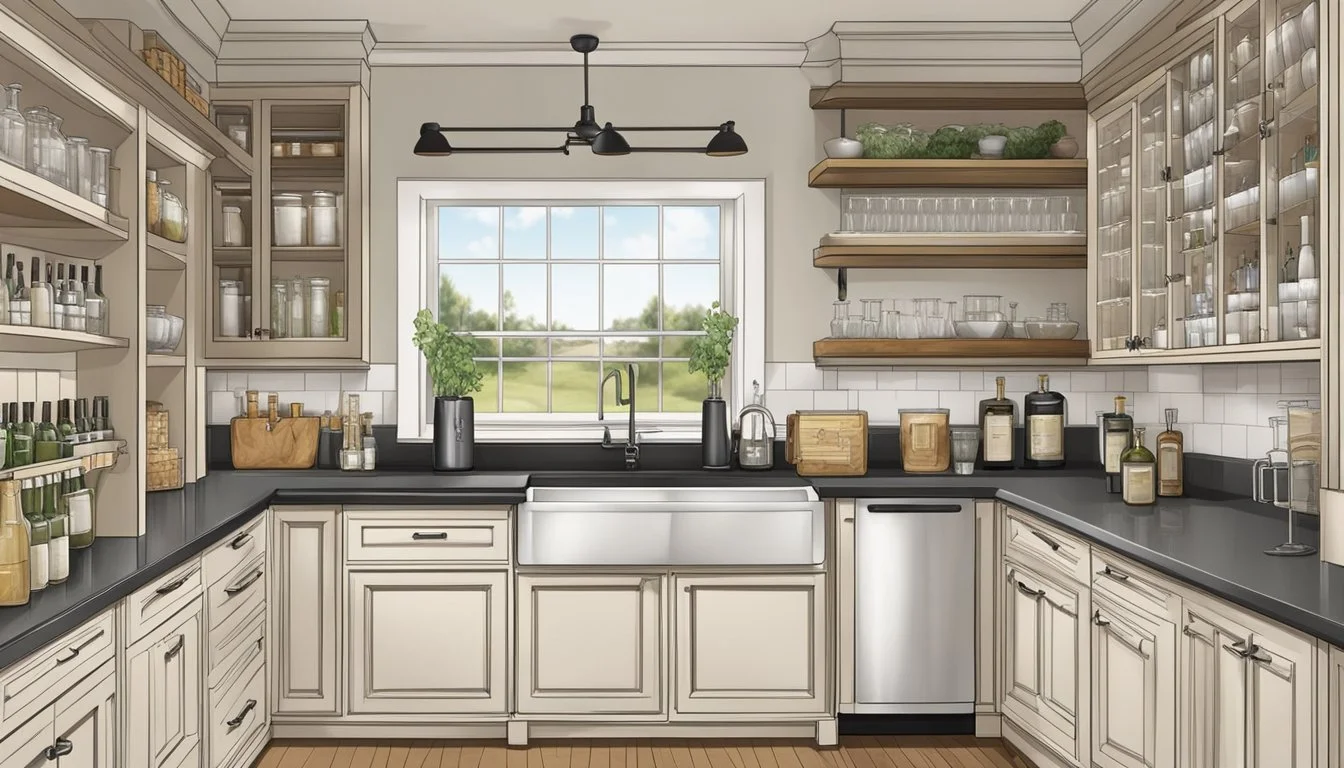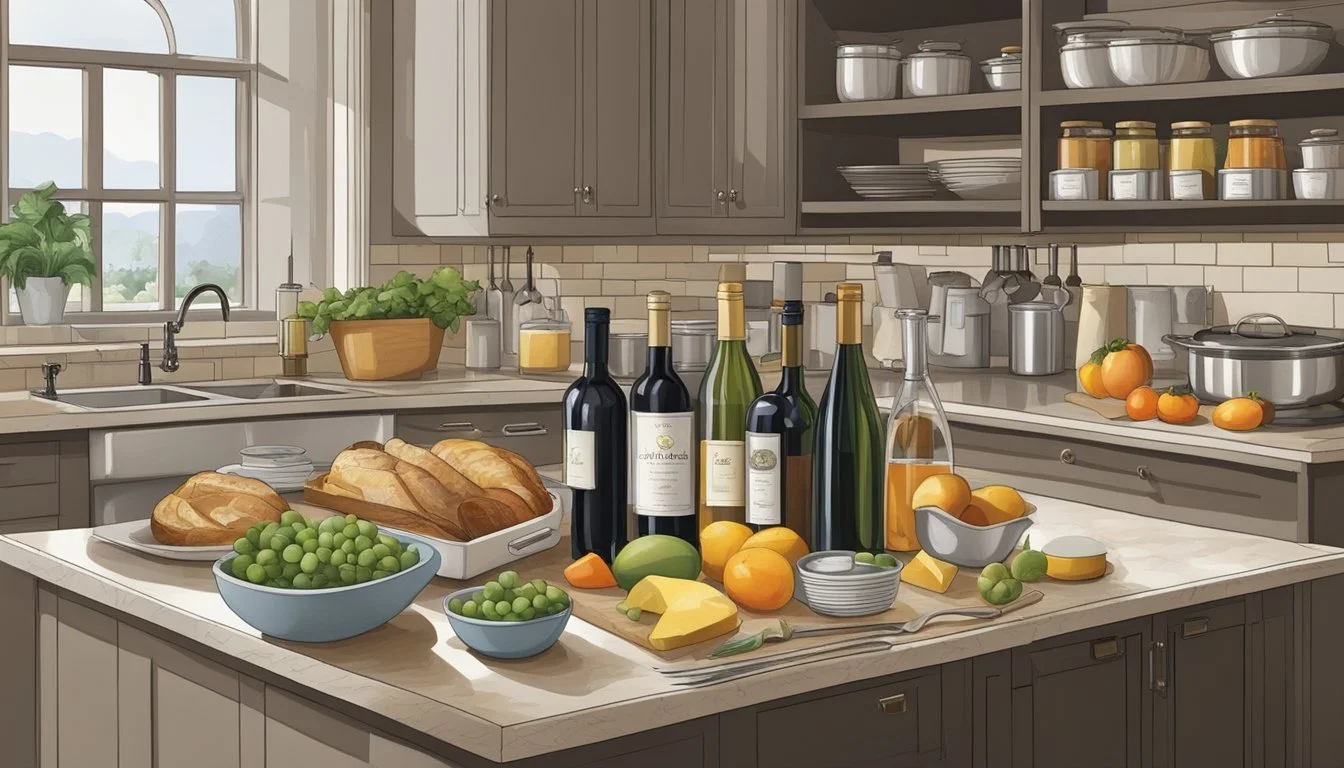5 Tips for Organizing Your Kitchen for a Dinner Party with a Sommelier
Streamline Your Space for Wine-Focused Entertaining
Hosting a dinner party can present a delightful yet demanding orchestration of food, beverages, and ambiance. When the occasion includes a sommelier, the culinary experience elevates, intertwining the nuances of wine with the flavors of the meal. As the host, organizing the kitchen becomes the cornerstone of a seamless evening. It is essential to ensure that every tool and ingredient is in place, not only to impress the guests but to provide a functional space for the wine expert's presentation.
Preparing the kitchen for such an event involves careful planning and strategic organization. It is advisable to declutter countertops to create a clean and accessible workspace. This act not only enhances the visual appeal but also facilitates the sommelier's interaction with guests, whether they are conducting wine tastings or pairing suggestions. Additionally, having all necessary utensils and dinnerware within reach simplifies serving and allows the host to focus on the guests rather than on last-minute searches for items.
Efficiency in the kitchen also extends to the post-meal phase, where the management of leftovers and cleanup plays a crucial role. Stocking up on adequate food storage options makes it easy for guests to take home a piece of the culinary experience. By paying attention to these organizational elements, the host can craft an enjoyable and memorable dinner (What wine goes well with dinner?) party that showcases the harmonious relationship between the selected wines and the prepared dishes.
Initial Preparations
The success of a dinner party often hinges on the readiness and organization of the kitchen. Ensuring a clutter-free environment and strategically organizing kitchen space are essential steps that should not be overlooked. Proper labeling is also a pivotal organizational task that paves the way for a smooth evening.
Decluttering Your Space
A sommelier's dinner party necessitates an uncluttered space for displaying and serving wine selections. It starts with decluttering countertops and work areas. Hosts should rigorously toss out unnecessary items and declutter to make room for the wine tasting and food serving stations. Organizing cabinets and drawers to remove duplicate items leans into the minimalist approach, ensuring that only essential items remain within reach.
Clear countertops of non-essential appliances and decor.
Evaluate each item in cabinets and drawers, removing duplicates and rarely used kitchen tools.
Strategizing Storage
With decluttered counters and succinctly populated cabinets, strategizing storage becomes much more manageable. Group like items together—glasses with glasses, plates with plates—to streamline both the aesthetics and functionality of the space. It's particularly important for items such as glasses and decanters, as the sommelier will need quick and easy access to the correct wine serving tools.
Assign designated spaces in cabinets and drawers for each category of kitchenware.
Place frequently used items in easily accessible locations.
Labeling Essentials
Employing a label maker can make the organization effective and user-friendly. Labels assist in quickly identifying contents in cabinets and drawers which is indispensable during the sometimes-hectic moments of a dinner party. Moreover, labels can help guide the sommelier and guests alike in locating glasses, wine accessories, and other essentials without having to ask the host and interrupt the flow of the evening.
Create labels for shelves and storage containers to specify contents or categories.
Use a label maker for a clean, consistent look, ensuring labels are easy to read and appropriately sized.
Organizing for Efficiency
In preparation for a dinner party with a sommelier, an efficiently organized kitchen is crucial. Proper space optimization, strategic grouping of items, and use of clear containers contribute to a functional and inviting space.
Space Optimization
Maximizing counter space and pantry organization ensures easy access to frequently used items. Small appliances should be stored in cabinets or on shelves, freeing up counter space for meal preparation. Pots and pans are ideally placed near the stove, arranged by function and frequency of use. A pot rack above the stove or hooks can be a space-saving solution.
Grouping Similar Items
An organized kitchen groups items by their purpose, which streamlines workflow. Silverware is best stored in drawer organizers, enabling quick table setting. Glassware might be sorted by type, bringing efficiency to both setting up for the party and serving drinks. In the pantry, one could group garnishes together to expedite the process of adding those finishing touches.
Silverware: Organize in drawer dividers.
Glassware: Sort by type; wine glasses separate from tumblers.
Garnishes: Group together for easy access.
Utilizing Clear Containers
Clear containers for Tupperware and other plastic containers help in identifying contents quickly, minimizing time spent searching. One should ensure containers are stackable to conserve space. Similarly, organizing dry goods in clear, labeled bins can aid the sommelier in selecting appropriate pairings without hassle.
Tupperware: Stackable, clear, and labeled.
Plastic Containers: Consolidate and store with lids on or nearby.
Dry Goods: Use clear bins, label for easy identification.
Kitchen Workflow
A well-organized kitchen workflow is paramount for the success of any dinner party, especially one featuring a sommelier. Efficient use of space and strategic placement can ease the transition from cooking to serving, enhancing the experience for both the host and the guests.
Preparing the Cooking Area
When preparing the cooking area, one should focus on clear and accessible countertops as they serve as the primary workstation for preparing dishes. The following steps help ensure a seamless cooking experience:
Refrigerate and Freeze: Start by sorting through the refrigerator and freezer to make room for pre-party ingredients and beverages. Any extraneous items should be stored or used ahead of time to prioritize space for the event's essentials.
Sort Cookware and Utensils: Align utensils and cookware based on the course sequence. Group items according to their use in appetizers, main courses, or desserts to avoid confusion during peak cooking times.
Ready Serving Dishes: Ensure serving dishes are clean, matched with the appropriate utensils, and placed within reach to streamline the transition from the oven to the buffet.
Tip: For a dinner with a sommelier, consider the pairing of wines with courses when organizing cookware and utensils, so the flow of the dinner is harmonized with the wine service.
Setting Up Serving Stations
Buffet-style serving stations not only save space but also encourage guest interaction. To effectively set up serving stations, keep in mind the following:
Designate Areas: Designate specific areas for different types of food and drink to prevent bottlenecks. For instance, a separate station for wines curated by the sommelier can elevate the dining experience.
Label Serving Stations: Clearly label each station to guide guests smoothly through their choices, allowing them to focus on enjoying the selection rather than navigating the layout.
Implement Traffic Flow: Establish a clear traffic flow to and from the buffet to ensure guests can move effortlessly, enhancing their overall experience during the event.
By adhering to these strategies in preparing the cooking area and setting up serving stations, one can create an inviting atmosphere that complements the curated wine selections and the carefully prepared menu.
Food and Drink Preparation
When organizing a kitchen for a dinner party with a sommelier, it is crucial to meticulously plan the food and beverages. The menu must be thoughtfully curated to complement the wine selections, and the layout of the bar area should facilitate easy access and display of drinks.
Curating a Themed Menu
The menu should reflect a theme that ties the food and wine together cohesively. Themed menus may revolve around regional cuisines or seasonal ingredients, creating a harmonious dining experience. For example, an Italian-themed menu might feature classic dishes such as risotto, bruschetta, and tiramisu, specifically chosen to pair with corresponding Italian wines.
Pairing Wines and Appetizers
The key to a successful appetizer selection lies in its pairing potential with the wines offered. A sommelier will typically recommend cheese, nuts, and meat selections that complement the evening's wine list. For instance:
Chardonnay pairs well with Camembert or Brie
Pinot Noir complements nutty flavors and can be served with almonds or cashews
Bold reds like Cabernet Sauvignon enhance the taste of red meats
A table could be set up showcasing these pairings for guests to easily match their appetizers with their wines.
Arranging the Bar Area
The bar area should be strategically arranged to showcase the wine selection while providing a functional space for guests to select their drinks. Essential supplies, such as wine glasses, corkscrews, and napkins, should be readily accessible. It is also advisable to prepare a small area for non-alcoholic options, ensuring that all guests have choices. The bar itself can be highlighted with a layout that places greens and florals to enhance the aesthetic appeal.
Final Touches
In readiness for a dinner party, paying attention to final touches is essential for creating a refined atmosphere. These details enhance guests' experiences, particularly when a sommelier is facilitating the evening, highlighting the interplay between fine wines and exquisite dishes.
Creating an Ambience
The ambiance of the kitchen sets the tone for the evening. Here, lighting is crucial; it should be soft enough to create a warm, inviting glow yet bright enough to allow the sommelier to present and examine the wines accurately. Consider using dimmers or candles to achieve this balance. Background music should be selected to complement the mood — gentle classical or jazz tracks often work well without overpowering conversation.
Additionally, the sommelier will need a well-lit space to display the wines. A side table with a white cloth helps to highlight the bottles' labels and assists in assessing the wine's color and clarity.
Preparing for Guests Arrival
As guests arrive, ensure a stress-free environment by having a dedicated area for their coats and belongings. The kitchen must be well organized with glasses polished and arranged — separate those for white, red, and dessert wines. The sommelier may also require specific glasses for different varietals, so it helps to consult with them beforehand.
For the dinner table, strategically place condiments and garnishes within easy reach. Bowls of fresh herbs, spices, and sauces not only add flavor to your guests' plates but also decorate the table with splashes of color and texture. The dessert area should be pre-arranged with plates, forks, and space for the dessert wines to be served alongside the final course.
One mustn't forget to prepare small cards or markers that denote the types of wines presented by the sommelier, adding an educational element to the entertaining experience. This allows guests to learn and engage more deeply with the pairing process. In reinforcing these final touches, hosts can create a sophisticated and comfortable environment that encourages guests to relax, interact with the experts, and immerse themselves in the joy of entertaining.





